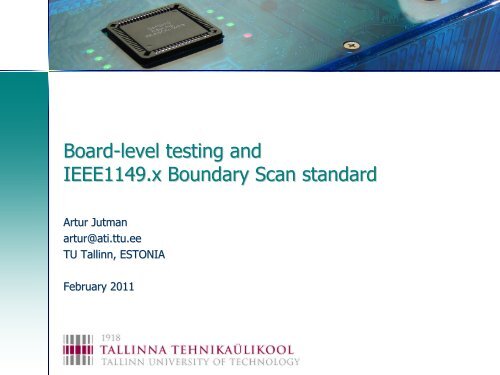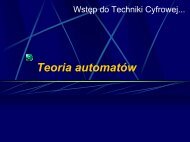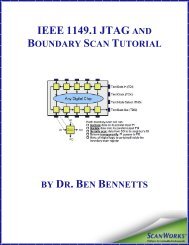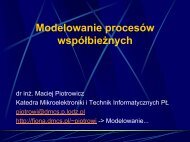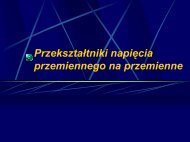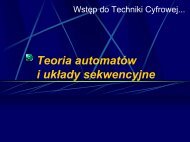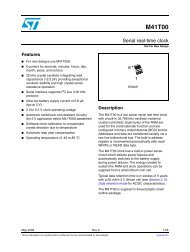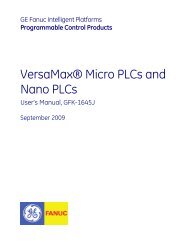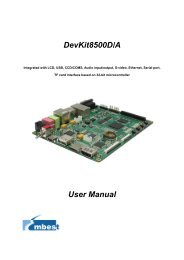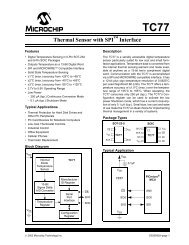Slides explaining Boundary Scan test principles - goJTAG
Slides explaining Boundary Scan test principles - goJTAG
Slides explaining Boundary Scan test principles - goJTAG
Create successful ePaper yourself
Turn your PDF publications into a flip-book with our unique Google optimized e-Paper software.
Board-level <strong>test</strong>ing and<br />
IEEE1149.x <strong>Boundary</strong> <strong>Scan</strong> standard<br />
Artur Jutman<br />
artur@ati.ttu.ee<br />
TU Tallinn, ESTONIA<br />
February 2011
Outline<br />
• Board level <strong>test</strong>ing challenges<br />
• Fault modeling at board level (digital)<br />
• Test generation for interconnect faults<br />
• IEEE 1149.1 <strong>Boundary</strong> <strong>Scan</strong> Standard<br />
• Application of <strong>Boundary</strong> <strong>Scan</strong><br />
2
Industrial approach to board <strong>test</strong><br />
• Visual inspection<br />
• Optical/x-ray inspection<br />
• Smoke <strong>test</strong> ;-);<br />
• Power distribution <strong>test</strong><br />
• Structural <strong>test</strong><br />
– in-circuit <strong>test</strong> (ICT)<br />
– <strong>Boundary</strong> <strong>Scan</strong> (BS)<br />
– Test Processors/Cores (BIST)<br />
• Functional <strong>test</strong> (FT)<br />
3
The <strong>test</strong> access problem…<br />
Limited access (nail probing) for <strong>test</strong>,<br />
measurement, diagnostics<br />
open<br />
fault<br />
BGA<br />
BGA<br />
short<br />
fault<br />
conductive<br />
layers<br />
crack<br />
IC<br />
PCB<br />
4
Test Access: Past and Present<br />
• Past: <strong>test</strong> access was a problem<br />
• Present: good <strong>test</strong> access by <strong>Boundary</strong> <strong>Scan</strong> combined<br />
with AOI, Functional Test, Flying Probe, etc.<br />
Test access by<br />
typical <strong>test</strong> methods<br />
1980 1990 2000 2010<br />
2020<br />
<strong>Boundary</strong> <strong>Scan</strong><br />
AOI and AXI<br />
Functional Testing<br />
Flying Probe<br />
In-Circuit Testing<br />
Extended BS<br />
5
The Challenge of Board Testing<br />
Tested chips placed on board<br />
<br />
Interconnects and soldering to<br />
be actually <strong>test</strong>ed at board-level!<br />
Source: Elcoteq<br />
Source: Intel<br />
6
Modeling of Interconnect Faults<br />
Net-level defect types and models<br />
• Short faults<br />
• Open faults<br />
• Delay faults<br />
• Noise/crosstalk<br />
static behavior<br />
dynamic behavior<br />
• Ground bounce<br />
• …<br />
7
Short Faults<br />
Possible shorts: : bond wire, leg, solder, interconnect<br />
Shorts are usually modeled as wired-AND, wired-OR faults<br />
8
Open Faults<br />
Misplaced bond wire<br />
Misplaced component<br />
Possible opens: : bond wire, leg, solder, interconnect<br />
Opens usually behave like stuck-at or delay faults<br />
9
Tri-state connections<br />
Main difference between logic circuits and<br />
board-level systems is the way the<br />
components are connected.<br />
Typical board-level interconnect uses tri-state<br />
logic: : logic-0, logic-1, and “high impedance”<br />
(switched off) state. Common notation: 0,1,Z.<br />
There are special “enable” signals that control<br />
this additional state of the I/O pins.<br />
10
Tri-state connections<br />
Chip 1 Chip 2<br />
Chip 3 Chip 4<br />
• Nets with several drivers<br />
• Nets with bi-directional pins<br />
11
Tri-state net structure<br />
enable<br />
data<br />
pin<br />
pin<br />
data_in<br />
enable<br />
data<br />
pin<br />
data_in<br />
12
Specific faults in tri-state nets<br />
Driver faults<br />
–stuck-driving fault<br />
–stuck-not-driving fault<br />
–stuck-at fault<br />
Net opens<br />
–stuck-at fault (0 or 1)<br />
–delay fault<br />
Net shorts<br />
–zero dominance<br />
• wired AND (mutual 0-dom.) 0<br />
–one dominance<br />
• wired OR (mutual 1-dom.) 1<br />
–net dominance<br />
• strong driver fault<br />
13
Outline<br />
• Board level <strong>test</strong>ing challenges<br />
• Fault modeling at board level (digital)<br />
• Test generation for interconnect faults<br />
• IEEE 1149.1 <strong>Boundary</strong> <strong>Scan</strong> Standard<br />
• Application of <strong>Boundary</strong> <strong>Scan</strong><br />
14
Consider a simple example…<br />
Test Vector<br />
or<br />
Parallel Test<br />
Vector = PTV<br />
010011<br />
… two circuits, 4 wires, plain topology<br />
010011<br />
010110<br />
010110<br />
011001<br />
011001<br />
011100<br />
011100<br />
Code Word<br />
or<br />
Serial Test<br />
Vector = STV<br />
Driver<br />
Receiver<br />
15
Test generation for interconnect faults<br />
… two circuits, 4 wires, plain topology<br />
1<br />
0<br />
1<br />
Open<br />
Assume stuck-at-0<br />
Short<br />
Assume wired AND<br />
0<br />
0<br />
0<br />
How many <strong>test</strong><br />
vectors are<br />
enough to cover<br />
all possible<br />
interconnect faults<br />
(opens and<br />
shorts)?<br />
1<br />
1<br />
Opens usually behave like stuck-at or delay faults<br />
Shorts are usually modeled as wired-AND or wired-OR<br />
16
The Counting Sequence<br />
00<br />
01<br />
Open<br />
Assume stuck-at-0<br />
00<br />
00<br />
What about<br />
opens?<br />
Short<br />
10<br />
Assume wired AND<br />
00<br />
11<br />
11<br />
Kautz showed in 1974 that a sufficient condition to detect any<br />
pair of short circuited nets was that the serial codes (STV) must<br />
be unique for all nets. Therefore the <strong>test</strong> length is ⎡log<br />
2<br />
(N)⎤<br />
17
The Modified Counting Sequence<br />
001<br />
010<br />
011<br />
Open<br />
Assume stuck-at-0<br />
Short<br />
Assume wired AND<br />
000<br />
010<br />
010<br />
Some of the<br />
observed error<br />
responses are<br />
allowed or<br />
correct codes.<br />
How to improve<br />
the diagnosis?<br />
100<br />
100<br />
All 0-s 0 s and all 1-s 1 s are forbidden STV codes because of open<br />
faults. Therefore the final <strong>test</strong> length is ⎡log<br />
2<br />
(N+2)⎤<br />
This method was proposed in 1982 by Goel & McMahon<br />
18
The True/Complement Code<br />
True<br />
part<br />
Complement<br />
part<br />
00 11<br />
01 10<br />
Open<br />
Assume stuck-at-0<br />
Short<br />
00 00<br />
00 00<br />
All-0 0 and<br />
all-1 1 codes<br />
are not<br />
forbidden<br />
anymore!<br />
10 01<br />
Assume wired AND<br />
00 00<br />
11 00<br />
11 00<br />
To improve the diagnostic resolution Wagner proposed the<br />
True/Complement Code in 1987.<br />
The <strong>test</strong> length became equal 2⎡log<br />
2<br />
(N)⎤<br />
19
The True/Complement Code<br />
True<br />
part<br />
Complement<br />
part<br />
00 11<br />
01 10<br />
10 01<br />
Open<br />
Assume stuck-at-0<br />
Short<br />
Assume wired AND<br />
00 00<br />
00 00<br />
00 00<br />
How to<br />
distinguish<br />
between<br />
opens and<br />
shorts?<br />
11 00<br />
11 00<br />
Important properties of the True/Complement Code are:<br />
There are equal numbers of 0-s 0 s and 1-s 1 s upon each line<br />
Hamming distance between any two code words is at least 2<br />
• Some shorts and opens cannot be distinguished (e.g. n2/n3)<br />
20
Extended True/Complement Code<br />
True<br />
part<br />
Complement<br />
part<br />
Open fault<br />
symptom<br />
01 00 11<br />
Code<br />
extension<br />
01 01 10<br />
01 10 01<br />
01 11 00<br />
Open<br />
Assume stuck-at-0<br />
Short<br />
Assume wired AND<br />
00 00 00<br />
01 00 00<br />
01 00 00<br />
01 11 00<br />
Idea: add two bits, that are the same at every STV code word<br />
Shorts and stuck-at faults are now distinguishable<br />
The <strong>test</strong> length is 2⎡log<br />
2<br />
(N)⎤+2<br />
21
Summary of TG Methods<br />
Counting Modified True/Compl<br />
Compl. Extended<br />
000<br />
001<br />
010<br />
011<br />
100<br />
101<br />
110<br />
111<br />
001<br />
010<br />
011<br />
100<br />
101<br />
110<br />
111 000<br />
110 001<br />
101 010<br />
100 011<br />
011 100<br />
010 101<br />
001 110<br />
000 111<br />
01 111 000<br />
01 110 001<br />
01 101 010<br />
01 100 011<br />
01 011 100<br />
01 010 101<br />
01 001 110<br />
01 000 111<br />
Walking<br />
10000000<br />
01000000<br />
00100000<br />
00010000<br />
00001000<br />
00000100<br />
00000010<br />
00000001<br />
LaMa<br />
00001<br />
00100<br />
00111<br />
01010<br />
01101<br />
10001<br />
…<br />
Length ⎡log 2 (N)⎤ ⎡log 2 (N+2)⎤ 2 ⎡log 2 (N)⎤ 2 ⎡log 2 (N)⎤+2 N ⎡log 2 (3N+2)⎤<br />
Example<br />
(N=10000)<br />
Hamming<br />
distance<br />
Defects<br />
Diagnostic<br />
Properties<br />
14 14 28 30 10000 15<br />
1 1 2 2 2 2<br />
Shorts<br />
Shorts<br />
Opens<br />
Shorts<br />
Opens<br />
/Delays/<br />
Bad Bad Good<br />
Shorts<br />
Opens<br />
Delays<br />
Very<br />
Good<br />
Shorts<br />
Opens<br />
/Delays/<br />
Very<br />
Good<br />
Shorts<br />
Opens<br />
Very<br />
Good<br />
22
More complex case: branching nets<br />
enable<br />
data<br />
data_in<br />
enable<br />
data<br />
data_in<br />
Driver Fault<br />
Open<br />
Short<br />
data<br />
data_in<br />
23
Additional rules for branching nets<br />
• Every driver on the net should at least once<br />
drive low and at least once drive high<br />
• Every receiver should at least once sense 0<br />
and at least once sense 1<br />
• Two or more drivers on the same net should<br />
never drive simultaneously<br />
• One can distinguish between a driver fault<br />
and open net by sensing back on a bi-<br />
directional pin<br />
24
Outline<br />
• Board level <strong>test</strong>ing challenges<br />
• Fault modeling at board level (digital)<br />
• Test generation for interconnect faults<br />
• IEEE 1149.1 <strong>Boundary</strong> <strong>Scan</strong> Standard<br />
• Application of <strong>Boundary</strong> <strong>Scan</strong><br />
25
IEEE 1149.1 <strong>Boundary</strong> <strong>Scan</strong>: History<br />
• Early 1980’s – problem of <strong>test</strong> access to PCBs via<br />
“bed-of-nails” fixture<br />
• Mid 1980’s – Joint European Test Action Group<br />
(JETAG)<br />
• 1986 – US companies involved: JETAG -> > JTAG<br />
• 1990 – JTAG Test Port became a standard [4]:<br />
IEEE Std. 1149.1: Test Access Port and <strong>Boundary</strong><br />
<strong>Scan</strong> Architecture comprising serial data channel<br />
with a 4/5-pin interface and protocol<br />
26
Test Access Via <strong>Boundary</strong> <strong>Scan</strong><br />
TDI<br />
TDO<br />
27
Test Access Via <strong>Boundary</strong> <strong>Scan</strong><br />
28
Test Access Via <strong>Boundary</strong> <strong>Scan</strong><br />
Driver<br />
Sensor<br />
Virtual<br />
nails<br />
Defects covered:<br />
driver scan cell, driver amp, bond wire, leg, solder,<br />
interconnect, solder, leg, bond wire, driver amp, sensor<br />
scan cell<br />
29
Test Access Via <strong>Boundary</strong> <strong>Scan</strong><br />
JTAG<br />
I/O<br />
TAP<br />
port<br />
ADDR<br />
DATA<br />
CONTROL<br />
ADDR<br />
A D C<br />
DATA<br />
CTRL<br />
I/O<br />
Printed Circuit Board<br />
30
<strong>Boundary</strong> <strong>Scan</strong> basics<br />
Pin<br />
Pin<br />
Core<br />
Logic<br />
Core<br />
Logic<br />
B<strong>Scan</strong> Cell<br />
Non-B<strong>Scan</strong> Device<br />
TDI<br />
TCK<br />
TMS<br />
TAP<br />
controller<br />
B<strong>Scan</strong> Device<br />
TDO<br />
... some extra<br />
logic is needed<br />
for Test Access<br />
For describing <strong>Boundary</strong> <strong>Scan</strong> devices<br />
BSDL (<strong>Boundary</strong> <strong>Scan</strong> Description<br />
Language) models are used<br />
31
IEEE 1149.1 Device Architecture<br />
BS Cells<br />
Core<br />
Logic<br />
TDI<br />
(Test Data In)<br />
MUX<br />
Bypass<br />
Identification<br />
Register<br />
MUX<br />
TDO<br />
(Test Data Out)<br />
(Test Mode Select)<br />
TMS<br />
TCK<br />
(Test Clock)<br />
Instruction<br />
Register<br />
TAP<br />
Controller<br />
Test Reset<br />
(Optional)<br />
32
Typical <strong>Boundary</strong> <strong>Scan</strong> Cell (BC_1)<br />
BC_1 is used both at input and output pins<br />
<strong>Scan</strong> Out<br />
(SO)<br />
Mode<br />
Data In<br />
(PI)<br />
0<br />
1<br />
Capture<br />
<strong>Scan</strong> Cell<br />
D Q<br />
Update<br />
Hold Cell<br />
D Q<br />
0<br />
1<br />
Data Out<br />
(PO)<br />
Clk<br />
Clk<br />
<strong>Scan</strong> In<br />
(SI)<br />
ShiftDR ClockDR<br />
UpdateDR<br />
33
<strong>Boundary</strong> <strong>Scan</strong> Instructions<br />
Instruction<br />
SAMPLE /PRELOAD<br />
EXTEST<br />
BYPASS<br />
IDCODE<br />
INTEST<br />
CLAMP<br />
HIGHZ<br />
RUNBIST<br />
USERCODE<br />
Status<br />
Mandatory<br />
Mandatory<br />
Mandatory<br />
Optional<br />
Optional<br />
Optional<br />
Optional<br />
Optional<br />
Optional<br />
34
<strong>Boundary</strong> <strong>Scan</strong> Working Modes<br />
SAMPLE/PRELOAD instruction – sample mode<br />
Get snapshot of normal chip output signals<br />
ShiftDR<br />
SO<br />
Mode<br />
ShiftDR<br />
SO<br />
Mode<br />
0<br />
1<br />
D Q<br />
D Q<br />
0<br />
1<br />
Core<br />
Logic<br />
0<br />
1<br />
D Q<br />
D Q<br />
0<br />
1<br />
Clk<br />
Clk<br />
Clk<br />
Clk<br />
SI<br />
ClockDR UpdateDR<br />
SI<br />
ClockDR UpdateDR<br />
Get snapshot of normal chip output signals<br />
Core<br />
Logic<br />
TDI<br />
TDO<br />
35
<strong>Boundary</strong> <strong>Scan</strong> Working Modes<br />
SAMPLE/PRELOAD instruction – preload mode<br />
Shift out snapshot data and shift in new <strong>test</strong> data to be used later<br />
ShiftDR<br />
SO<br />
Mode<br />
ShiftDR<br />
SO<br />
Mode<br />
0<br />
1<br />
D Q<br />
D Q<br />
0<br />
1<br />
Core<br />
Logic<br />
0<br />
1<br />
D Q<br />
D Q<br />
0<br />
1<br />
Clk<br />
Clk<br />
Clk<br />
Clk<br />
SI<br />
ClockDR UpdateDR<br />
SI<br />
ClockDR UpdateDR<br />
Shift out snapshot data and shift in new<br />
<strong>test</strong> data to be used later<br />
TDI<br />
Core<br />
Logic<br />
TDO<br />
36
<strong>Boundary</strong> <strong>Scan</strong> Working Modes<br />
EXTEST<br />
instruction – driving and sensing:<br />
Test off-chip circuits and board-level interconnections<br />
ShiftDR<br />
SO<br />
Mode<br />
ShiftDR<br />
SO<br />
Mode<br />
0<br />
1<br />
D Q<br />
D Q<br />
0<br />
1<br />
Core<br />
Logic<br />
0<br />
1<br />
D Q<br />
D Q<br />
0<br />
1<br />
Clk<br />
Clk<br />
Clk<br />
Clk<br />
SI<br />
ClockDR UpdateDR<br />
SI<br />
ClockDR UpdateDR<br />
Test off-chip circuits and board-level<br />
interconnections<br />
TDI<br />
Core<br />
Logic<br />
TDO<br />
37
<strong>Boundary</strong> <strong>Scan</strong> Working Modes<br />
EXTEST<br />
instruction – shifting<br />
Shift out snapshot data and shift in new <strong>test</strong> data to be used later<br />
ShiftDR<br />
SO<br />
Mode<br />
ShiftDR<br />
SO<br />
Mode<br />
0<br />
1<br />
D Q<br />
D Q<br />
0<br />
1<br />
Core<br />
Logic<br />
0<br />
1<br />
D Q<br />
D Q<br />
0<br />
1<br />
Clk<br />
Clk<br />
Clk<br />
Clk<br />
SI<br />
ClockDR UpdateDR<br />
SI<br />
ClockDR UpdateDR<br />
Shift out snapshot data and shift in new<br />
<strong>test</strong> data to be used later<br />
TDI<br />
Core<br />
Logic<br />
TDO<br />
38
Typical BS Interconnect Test Flow<br />
BS mode<br />
Test bus<br />
actions<br />
Test data manipulations<br />
Test<br />
PRELOAD<br />
IRshift +<br />
DRshift<br />
Loading the first <strong>test</strong> vector to BS register (vector<br />
includes control/disable values for other devices<br />
on the bus)<br />
Vector 1 loaded<br />
EXTEST<br />
IRshift +<br />
DRshift<br />
1. Applying vector 1 to the DUT<br />
2. Capturing <strong>test</strong> responses from DUT in BS reg.<br />
3. Reading back <strong>test</strong> responses and loading new <strong>test</strong><br />
vector to BS register<br />
Vector 1 applied<br />
and analyzed<br />
EXTEST<br />
DRshift<br />
1. Applying vector 2 to the DUT<br />
2. Capturing <strong>test</strong> responses from DUT in BS reg.<br />
3. Reading back <strong>test</strong> responses & and loading new <strong>test</strong><br />
vector to BS register<br />
Vector 2 applied<br />
and analyzed<br />
EXTEST<br />
DRshift<br />
1. Applying vector N to the DUT<br />
2. Capturing <strong>test</strong> responses from DUT in BS reg.<br />
3. Reading back <strong>test</strong> responses<br />
Vector N applied<br />
and analyzed<br />
Time<br />
N <strong>test</strong> vectors: (N+1) DRshifts + 2 IRshifts ≈ (N+1) DRshifts<br />
39
<strong>Boundary</strong> <strong>Scan</strong> Working Modes<br />
BYPASS<br />
instruction:<br />
Bypasses the<br />
corresponding<br />
chip using 1-bit 1<br />
register<br />
TDI<br />
Shift DR<br />
Clock DR<br />
D Q<br />
Clk<br />
To TDO<br />
Core<br />
Logic<br />
Core<br />
Logic<br />
Core<br />
Logic<br />
TDI<br />
BYPASS<br />
SAMPLE<br />
BYPASS<br />
TDO<br />
Similar instructions: CLAMP, HIGHZ<br />
40
<strong>Boundary</strong> <strong>Scan</strong> Working Modes<br />
IDCODE instruction:<br />
Connects the component device identification register serially<br />
between TDI and TDO in the Shift-DR TAP controller state<br />
Allows board-level <strong>test</strong> controller or external <strong>test</strong>er to read out<br />
component ID<br />
Required whenever a JEDEC identification register is included<br />
in the design<br />
TDI<br />
Version Part Number Manufacturer ID 1<br />
TDO<br />
4-bits<br />
Any format<br />
16-bits<br />
Any format<br />
11-bits<br />
Coded form of JEDEC<br />
41
Blind Interrogation<br />
Default instruction:<br />
• IDCODE (but it is not mandatory)<br />
• BYPASS (if IDCODE is not implemented)<br />
Default capture bits:<br />
• 0 in BYPASS register<br />
• 1 – first bit in IDCODE register<br />
Example: 0...............................10<br />
Core<br />
Logic<br />
Core<br />
Logic<br />
Core<br />
Logic<br />
TDI<br />
0 ….…..…1 0<br />
BYPASS<br />
IDCODE<br />
BYPASS<br />
TDO<br />
42
TAP Controller State Diagram<br />
DR Branch<br />
IR Branch<br />
The TAP state diagram<br />
has two main branches<br />
and two idle states.<br />
Shift IR and Shift DR<br />
states are used to insert<br />
instructions and <strong>test</strong><br />
data into the BS device.<br />
These are the most<br />
important states.<br />
The number of states is<br />
exactly 16 (to avoid<br />
some undefined states)<br />
TMS signal is used to<br />
move through the states<br />
43
<strong>Boundary</strong> <strong>Scan</strong> in Motion (Demo)<br />
http://www.<strong>goJTAG</strong>.com<br />
44
Outline<br />
• Board level <strong>test</strong>ing challenges<br />
• Fault modeling at board level (digital)<br />
• Test generation for interconnect faults<br />
• IEEE 1149.1 <strong>Boundary</strong> <strong>Scan</strong> Standard<br />
• Application of <strong>Boundary</strong> <strong>Scan</strong><br />
45
B<strong>Scan</strong> Implementation Rules<br />
• One or more BSC at each system input or<br />
output of on-chip system logic (core logic)<br />
• BSC may be connected to chip-internal<br />
internal<br />
signals<br />
• No BSC on:<br />
– TAP pins (TCK, TMS, TDI, TDO, TRST)<br />
– Compliance Enable Pins<br />
– Non-digital pins (e.g. analog pins, power pins)<br />
• No logic between BSC and I/O pin it is<br />
connected to (a buffer is allowed)<br />
46
B<strong>Scan</strong> Implementation Examples<br />
VCC<br />
+<br />
–<br />
Analog<br />
Core<br />
Logic<br />
(digital)<br />
B<strong>Scan</strong> Cell<br />
GND<br />
TDI<br />
TCK<br />
TMS<br />
TAP<br />
controller<br />
TDO<br />
47
Board-level Test using <strong>Boundary</strong> <strong>Scan</strong><br />
JTAG connector<br />
TDI<br />
TMS<br />
TCK<br />
TDO<br />
Interconnect<br />
Logic<br />
Interconnect<br />
Logic<br />
TAP TAP TAP<br />
Infrastructure <strong>test</strong> (generated by using BSDL models)<br />
Interconnect <strong>test</strong> (BSDL models + interconnection netlist)<br />
Board (UUT)<br />
48
Board-level Test using <strong>Boundary</strong> <strong>Scan</strong><br />
Infrastructure <strong>test</strong><br />
Interconnect <strong>test</strong><br />
– One needs to specify behavioral models for non-BS<br />
components to get acceptable <strong>test</strong> coverage<br />
– No standard description format exists<br />
Additional tasks:<br />
Cluster logic <strong>test</strong> – semi-automated<br />
RAM Test<br />
External connectors <strong>test</strong><br />
LED or display <strong>test</strong> (can be assisted by a camera/sensor)<br />
FLASH <strong>test</strong>/program/read ID – in-system programming<br />
49
Interconnect Test through Clusters<br />
Unidirectional buffer<br />
B<strong>Scan</strong><br />
IC 1<br />
OE 1<br />
IN 2<br />
Buffer<br />
3 OUT<br />
B<strong>Scan</strong><br />
IC 2<br />
Bidirectional buffer<br />
B<strong>Scan</strong><br />
IC 1<br />
DIR 1<br />
INOUT 2<br />
Buffer<br />
3 INOUT<br />
B<strong>Scan</strong><br />
IC 2<br />
B<strong>Scan</strong><br />
IC 3<br />
50
Cluster Logic Test (Manual)<br />
B<strong>Scan</strong><br />
IC 1<br />
&<br />
1<br />
B<strong>Scan</strong><br />
IC 2<br />
Cluster’s s truth table is needed<br />
Truth table<br />
000 0<br />
001 1<br />
010 1<br />
…<br />
111 1<br />
51
RAM / Flash Test<br />
B<strong>Scan</strong><br />
IC 1<br />
Chip select lines<br />
B<strong>Scan</strong><br />
IC 2<br />
RAM 1<br />
RAM 2<br />
Flash<br />
To generate <strong>test</strong>:<br />
• Specify constraints that will select only one device<br />
• RAM/Flash model in special format that provides<br />
description of read/write protocol<br />
• Combination of walking and counting sequences is<br />
used<br />
52
RAM Test Example<br />
Address 10bit<br />
walking 1<br />
0000000000<br />
1000000000<br />
0100000000<br />
0010000000<br />
0001000000<br />
0000100000<br />
0000010000<br />
0000001000<br />
0000000100<br />
0000000010<br />
0000000001<br />
Data 32 bit<br />
counting sequence (true/complement)<br />
….…write here something unique……<br />
…….<br />
01010101010101010101010101010101<br />
00110011001100110011001100110011<br />
00001111000011110000111100001111<br />
00000000111111110000000011111111<br />
00000000000000001111111111111111<br />
10101010101010101010101010101010<br />
11001100110011001100110011001100<br />
11110000111100001111000011110000<br />
11111111000000001111111100000000<br />
11111111111111110000000000000000<br />
53
RAM Test Example: detection of shorts<br />
… assuming Wired-AND model<br />
• Any short between address lines will cause<br />
writing the corresponding PTV to address 0.<br />
• Any short between data lines will cause writing<br />
wrong data to the correct address.<br />
• Shorts between data and address lines need a<br />
double-lengths lengths <strong>test</strong> to generate all 1/0<br />
combinations between a particular address line<br />
and data lines. Such shorts will cause writing to<br />
address 0.<br />
• Fault detection: read from all involved<br />
addresses then read at address 0.<br />
54
RAM Test Example: detection of opens<br />
… assuming stuck-at 0 model<br />
• Any s-a-0 s 0 at address lines will cause writing the<br />
corresponding PTV to address 0.<br />
• Any s-a-0 s 0 at data lines will cause writing wrong<br />
data to the correct address.<br />
• Fault detection: read from all involved<br />
addresses then read at address 0.<br />
• The same procedures can be repeated for<br />
stuck-at 1 opens and Wired-OR shorts using<br />
complementary <strong>test</strong> data (walking-0 0 code).<br />
55
Testing External Connectors<br />
JTAG<br />
<strong>Boundary</strong> <strong>Scan</strong><br />
Controller<br />
B<strong>Scan</strong><br />
IC<br />
Matching Board or<br />
I/O module<br />
Board<br />
Only interconnect <strong>test</strong> will be performed!<br />
The real protocol of external connector is not <strong>test</strong>ed<br />
56
<strong>Boundary</strong> <strong>Scan</strong> Test Development<br />
Typical Workflow<br />
CAD Netlist<br />
Importer<br />
Parsed<br />
Netlist<br />
Classifier<br />
Constraints<br />
Functional<br />
models for<br />
RAM/Flash<br />
<strong>Scan</strong>-path<br />
configuration<br />
Parser<br />
Netlist with<br />
drive/sense<br />
constraints<br />
BSDL Models<br />
Models for non-BS<br />
components (buffers,<br />
ram, flash, etc)<br />
Interconnect<br />
ATPG<br />
RAM Test, Flash<br />
Test/Program<br />
Generator<br />
Compiled<br />
Test Data<br />
Constraints<br />
Compiled<br />
Test<br />
Program<br />
Test<br />
Coverage<br />
Report<br />
57
IEEE 1149.1 Summary<br />
<strong>Boundary</strong> <strong>Scan</strong> Standard has become absolutely<br />
essential:<br />
− No longer possible to <strong>test</strong> printed circuit<br />
boards with bed-of<br />
of-nails <strong>test</strong>er<br />
− Not possible to <strong>test</strong> multi-chip modules at all<br />
without it<br />
− Supports BIST, external <strong>test</strong>ing with<br />
Automatic Test Equipment, and boundary<br />
scan chain reconfiguration as BIST pattern<br />
generator and response compacter<br />
− Now getting widespread usage<br />
58
<strong>Boundary</strong> <strong>Scan</strong> – Evolution<br />
1149.4 – Mixed-Signal Test Bus (<strong>test</strong>ing analog signals)<br />
1149.6 – <strong>Boundary</strong>-<strong>Scan</strong> Testing of Advanced Digital<br />
Networks (<strong>test</strong>ing high speed links)<br />
1149.7 – CJTAG – Compact JTAG (debug)<br />
1149.8.1 – Sensing using capacitive plate<br />
P1687 – IJTAG – Internal JTAG (component <strong>test</strong>ing, BIST)<br />
1500 – Embedded Core Test (SoC <strong>test</strong>ing)<br />
1532 – In-System Configuration of Programmable Devices<br />
P1581 – Static Component Interconnection Test Protocol<br />
and Architecture (memory-to<br />
to-BS_chip<br />
links <strong>test</strong>ing)<br />
5001 – NEXUS – Global Embedded Processor Debug<br />
Interface (SW development, debug, and emulation)<br />
59
New Standards and Their Purposes<br />
• IEEE 1149.7 – improved flexibility of the JTAG bus<br />
by relaxing topology requirements and by<br />
addressing resources; potential data throughput<br />
improvements<br />
• IEEE P1149.8.1 – improved observability for<br />
measurement (from the JTAG standpoint) by<br />
implementing a capacitive sensing technology<br />
• IEEE P1149.1-2011<br />
– solves signaling issues on<br />
the buses by driver initialization procedures<br />
• IEEE P1687 – introduces the concept of embedded<br />
instrumentation for <strong>test</strong> application, measurement<br />
and diagnosis tasks<br />
• Processor emulation standards (e.g. NEXUS) and<br />
solutions – converts a MPU into a <strong>test</strong> instrument<br />
60
New and Emerging Standards Combined<br />
Board or chip<br />
Instruments<br />
IEEE P1687<br />
IEEE 1149.7<br />
IEEE 1149.1<br />
IEEE P1149.1-2011<br />
61
What to look further<br />
Leading B<strong>Scan</strong> companies:<br />
– Goepel Electronic (http://www.goepel.com<br />
www.goepel.com/)<br />
– ASSET Intertech (http://www.asset-intertech.com/)<br />
– JTAG Technologies (http://www.jtag.com<br />
www.jtag.com/)<br />
Training software:<br />
– <strong>goJTAG</strong> – open source project (http://www.<strong>goJTAG</strong>.com<br />
www.<strong>goJTAG</strong>.com/)<br />
– Trainer 1149 by Testonica Lab<br />
(http://www.<strong>test</strong>onica.com/1149/download)<br />
– <strong>Scan</strong> Coach by Goepel Electronic<br />
(http://www.goepel.com/index.php?id<br />
www.goepel.com/index.php?id=1418&L=4)<br />
– <strong>Scan</strong> Educator by Texas Instruments<br />
(http://focus.ti.com/docs/toolsw/folders/print/scan_educator.ht<br />
ml)<br />
Literature:<br />
– Kenneth P. Parker, The <strong>Boundary</strong>-<strong>Scan</strong> Handbook<br />
– Lecture notes by Ben Bennetts (try googling)<br />
62


